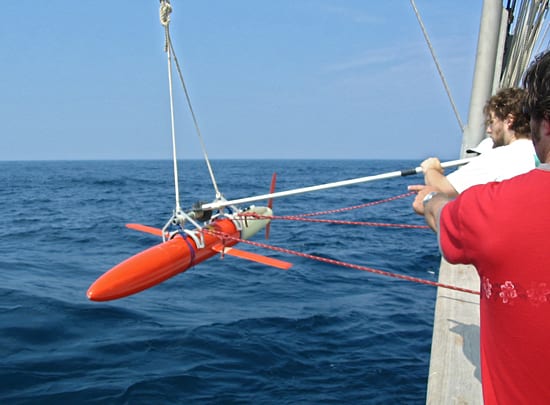Graduate students in the MIT/WHOI Joint Program practice deploying a Spray glider. A Spray glider, a sensor-equipped autonomous underwater vehicle, was recently deployed to the Gulf of Mexico to gather data involving the Deepwater Horizon oil spill.
WHOI Senior Scientist Breck Owens, who developed the Spray glider along with Russ Davis of the Scripps Institution of Oceanography, reports that according to the newly gathered data, a recently formed eddy appears to be blocking much of the spilled oil from entering the Gulf’s Loop Current. This is, at least for now, good news for Florida’s Gulf- and east coasts, as well as the east coast of the United States–all of which are adjacent to the Loop Current and the Gulf Stream into which it feeds. However, Owens emphasizes, significant amounts of oil continue to plague the coastlines of Louisiana, Mississippi, and Alabama.
The glider, which was launched in conjunction with two Navy gliders, has not yet found any evidence of oil in the 240-mile-wide eddy, said Owens, who communicates with the spray by email. The autonomous vehicle is remotely controlled via the Iridium communications satellite system. The Spray glider was named for the boat on which Joshua Slocum first circumnavigated Earth. Follow its path in the Gulf here.
(Photo by Photo by Derya Akkaynak)
Image and Visual Licensing
WHOI copyright digital assets (stills and video) on this website can be licensed for non-commercial use upon request and approval. Please submit your request via our Media Request Form.
For assistance or accessibility accommodations, call (508) 289-2647.
